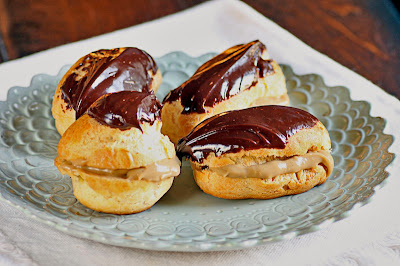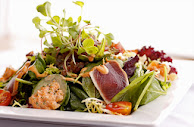For this week's French Fridays with Dorie recipe, Bistrot Paul Bert Pepper Steak, Dorie takes us to Bistrot Paul Bert, one of her favorite family-owed bistros in Paris. The tagline on the chalkboard menu always reads: Iciles viandes sont servies bleues, saignantes, ou malcuites...we serve meat blue [just barely warm in the center], rare, or badly cooked. She sings praises of the bistro's Steak Frites in her blog post, The Paris Ten: Must-Tastes...
To my mind, the best version of the classic steak-frites dish is found at Bistro Paul-Bert (18 rue Paul-Bert, Paris 11), which is a good thing for me because the place is also one of my hands-down favorite bistros, and you can't beat the combination of having the iconic dish in a setting that's Parisian through and through. It also doesn't hurt that Bistro Paul-Bert has a remarkable wine list.
 |
| carte postale du restaurant ©paul bert, from Linternaute |
It's been a while since we've enjoyed a nice steak, so I splurged on a couple of thick filets. At Bistrot Paul Bert, the steak comes with frites, and after reading The New York Times' article, Steak Frites: Seeking the Best of a Classic, and watching the accompanying slideshow narrated by Mark Bittman, Steakout in Paris, I had to try making Pommes Soufflé. They are adorable balloon-like fries that require peeling and slicing the potatoes 1/4 inch thick, preferably with a mandoline, soaking them in ice water for 25 minutes, patting dry, and then double-frying them, first in 325 degree F oil, and then a second time at 375 degrees. Proper puffage can be affected by the age of the potatoes, humidity in the air, and oil temperature. For your standard bistro frites, the double-frying method is also used, but the potatoes are not soaked in water - very important!
Bistro owner, Bertrand Auboyneau, uses filet mignon for his Pepper Steak, pressed with coarsely cracked Sarawak pepper, pan-seared, and topped with a quick Cognac and cream sauce. Dorie recommends using Sarawak pepper to replicate Bert's dish, and I tracked some down through Pepper-Passion.
Over the last hundred years, Sarawak Pepper has been exported throughout the world from Sarawak on Borneo Island, Malaysia. It has gained international recognition by chefs and gourmets as one of the favorite pepper ingredients due to its distinctive flavor and taste perfected through years of government research effort. It has a mild flavor with a fresh aroma that is often described as fruity, with hints of chocolate and Syrah.
 |
| The peppercorns are coarsely cracked with a mortar and pestle |
 |
| Cracked peppercorns sprinkled and pressed onto both sides of the filets |
Due to the thickness of our filets (those puppies were at least 2 inches thick), I was unable to fully cook them on top of stove with Dorie's method. I pan-seared them first, and then transferred the pan to the oven to finish cooking. I was not wowed by the Cognac-cream sauce - all I really tasted was cream. To add a bit more flavor, I added a touch more Cognac, cooked it down a bit, and then added a tiny bit of Worcestershire sauce and Dijon mustard, and a little more cream at the end. I achieved beautiful puffed potatoes with less than half of my potato slices, so we had a mix of Pommes Soufflé and potato chips, and steamed asparagus, with our Steak au Poivre.
There are slight variations of the Cognac-cream pan sauce that typically accompanies Steak au Poive, but I prefer the addition of some shallots and a little beef broth. Also, finishing the filets in the oven is necessary for thicker cuts of tenderloin. In Dorie's book, she also provides a recipe for Bistrot Paul Bert's Steak a la Bourguignonne - steak with red wine, garlic and shallot sauce. Next time I splurge on red meat, I'll be sure to try that sauce.
Filet of Beef au Poivre
Adapted from  Around My French Table: More Than 300 Recipes from My Home to Yours
Around My French Table: More Than 300 Recipes from My Home to Yours
Serves 2
Two 8-ounce filet mignon steaks
Kosher salt
1 tablespoon black peppercorns, coarsely ground
1 tablespoon unsalted butter
1 tablespoon extra-virgin olive oil
2 tablespoons minced shallots
1/2 cup canned beef broth
1/4 cup Cognac or brandy
1/4 cup heavy whipping cream
Preheat the oven to 375 degrees F.
Season both sides of the filet mignon with salt, and then press the black pepper evenly onto both sides of the filets. Allow to rest at room temperature for 15 minutes.
In a large heavy, ovenproof skillet, heat the butter and olive oil over medium-high heat until almost smoking. Place the filets in the hot pan and cook until well-seared on one side, about 3 minutes. Turn the filets over and then transfer the pan to the oven. Cook for about 10 minutes, or until the filets are medium-rare (internal temperature of 125-130 degrees F). Remove the filets to a platter to rest, and tent with aluminum foil to keep warm.
Return the pan to the stove over medium-high heat. Add the shallots to the pan and cook for 2 minutes. Add the beef broth and allow to reduce by half, scraping the brown bits from the bottom of the pan. Carefully add the Cognac (use caution, it may ignite), and cook over allow to simmer for about 2 minutes. Lower the heat to medium-low, add the cream, and simmer for 3-4 minutes. Season with salt to taste.
Serve the steaks with the sauce poured on top.
French Fridays with Dorie is an online cooking group, that just hit 2,000 members, dedicated to Dorie Greenspan‘s newest book, Around My French Table: More Than 300 Recipes from My Home to Yours. As members of the group, we have purchased the cookbook and cook along as much as we can. There is a new recipe each week, and we post about that recipe on Friday. We are asked to refrain from posting the actual recipes on our blog. The book is filled with stunning photography, and personal stories about each recipe, which makes it that much more intriguing. I highly recommend adding it to your cookbook collection if you haven't already!
























































